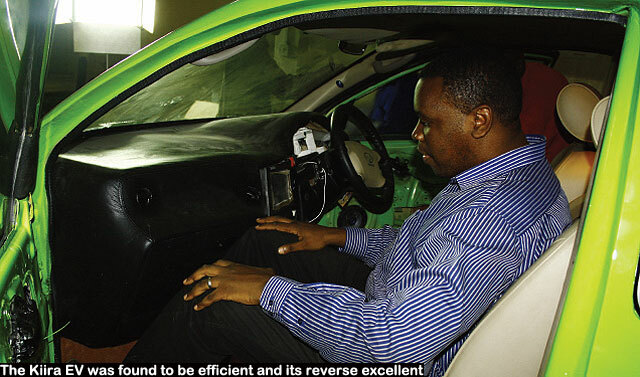Makerere launches electric car, set to embark on minibus. Kiira EV Launch Supplement
AS Makerere University launched their recently made electric car, Kiira EV, the team that brought it forth, is embarking on a new project
AS Makerere University launched their recently made electric car, Kiira EV, the team that brought it forth, is embarking on a new project: a 30-seater SUV minibus. Henry Mukasa spoke to the university officials about the background and future plans for the project.

The role of universities in innovation is more subtle than usually acknowledged. Universities that are active at the heart of successful technology clusters do not just spin out companies. They develop highly-skilled people who move between industry and academia; they incubate businesses and provide expertise; they produce knowledge that is used by technology businesses; they provide public space in which people from various overlapping branches of research meet.”
The above note by UK’s Policy Exchange website sums up the role of universities in this era of industrialisation. And one would think by manufacturing Kiira EV, an environment-friendly electronic car, Makerere University has broken into that league of universities.
Innovation and funding
It all started in 2008 when students of Massachusetts Institute of Technology (MIT), invited 27 universities worldwide, to participate in the building of a hybrid car, that uses both electricity and fuel. A group of students from Makerere’s College of Engineering, Design, Art and Technology participated in the global student-led consortium. At the end of it, they had designed an energy-efficient hybrid fuel-electricity prototype vehicle, Vision 200.
The car was exhibited at the Vehicle Design Summit hosted at the world design capital in Torino, Italy in 2009. The success of this initiative provided the impetus and belief among the college staff and students that there was inherent potential to push innovation forward.
“When they returned, we noticed the passion in them,” Prof. S.S Tickodri Togboa remarks.
The missing gap then was funding. However, when President Museveni interfaced with the college leaders and they briefed him on their plans, he was impressed and promised financial support. Under the Presidential Initiative at the university, the Government earmarked sh25b to the College of Engineering to fund technological research over five years.
The team
After resources were disbursed by Government in July 2010, the college commenced preparations for the project. Engineers were identified, several architectural designs drawn and simulation on the computer done and various models checked out. In February this year the manufacturing began.
The car was assembled by a team of eight. The team leader was Paul Isaac Musasizi, who also doubled as the Vehicle Project Makerere technical director. Others were Richard Madanda (electrical), Fred Matovu (mechanical), Jonathan Kasumba (Fine Artist), Gerald Baguma (programmer/ communications), Nasser Gyegenda (mechanical), Pauline Korukundo (programmer) and Nancy Ssenabulya (programmer/research assistant).
The overall head of the project was Prof. S.S Tickodri Togboa, a renowned professor of electrical engineering and computing, who is also the university’s deputy vice-chancellor.
“I told my students that we would come home and make our own car, and here it is, the dream has come to pass,” he adds.

Why Kiira EV?
Togboa explains that when the college team met the President, they proposed a name that would reflect Makerere in it, something like MAK. However, the President advised that since MAK name has been touted and flaunted in the arena of academics, there was need to promote another key national feature, like other countries do.
“He therefore proposed to reflect Kiira, the hydro power dam in Jinja that powers the nation, through generation of power,” Togboa explains. The vehicle is electric after all!
The mechanics
The green, two-seater Kiira EV weighs 1,000kg. The car is powered by a 40-amps 64-cells Lithium ion battery. While the ordinary car has a fuel combustion engine, Kiira EV has a power-train that is run by electric mortars and supported by batteries.
It’s built to cruise at a speed of over 100kmh. The battery can last for a distance of 80km (50 miles) before recharging for 3-4 hours with electric power.
Team leader, Musasizi explains that the choice of the car’s colour, green, was to illustrate the university’s commitment to good environmental practices which include, going green and reducing emissions. The car has zero emissions and is mute as it cruises.
“Apart from the stone and iron age, Uganda has been left out in technological development. Now we want to have a seat on the electric car bench in the world,” Musasizi remarks.
During the test drive the vehicle was found to be efficient. Although it jerked a bit on ignition, the car picked speed well and its reverse is excellent.
Challenge
Makerere says the electric car project is aimed at developing sustainable, affordable and environmentally-friendly transport solutions for Africa.
However, the cost of the prototype points at one of the biggest challenge this projects will face; affordability. At $35,000 (Sh98.3m), Kiira EV, when produced on large scale will not be within reach of most Ugandans and hence miss the local market. Perhaps the hope is in the promise by officials that the cost can be brought down to $15,000 (sh42.1m),